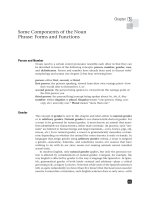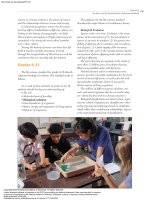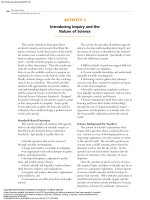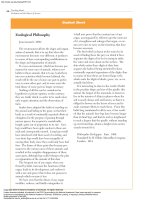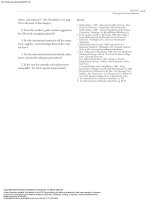Saladin Anatomy and Physiology The Unity of Form and Function Episode 6 docx
Bạn đang xem bản rút gọn của tài liệu. Xem và tải ngay bản đầy đủ của tài liệu tại đây (3.2 MB, 70 trang )
Saladin: Anatomy &
Physiology: The Unity of
Form and Function, Third
Edition
10. The Muscular System Text
© The McGraw−Hill
Companies, 2003
Chapter 10
Chapter 10 The Muscular System 335
infants. To appreciate this action, hold your fingertips
lightly on your cheeks as you make a kissing noise. You
will feel the relaxation of the buccinators at the moment
air is sharply drawn in through the pursed lips. The buc-
cinators also aid chewing by pushing and retaining food
between the teeth.
The platysma
25
is a thin superficial muscle that
arises from the shoulder and upper chest and inserts
broadly along the mandible and overlying skin. It
depresses the mandible, helps to open and widen the
mouth, and tenses the skin of the neck (during shaving, for
example).
Muscles of Chewing and Swallowing
The following muscles contribute to facial expression and
speech but are primarily concerned with manipulation of
food, including tongue movements, chewing, and swal-
lowing (table 10.3).
Frontalis
Levator palpebrae
superioris
Zygomaticus major
and minor
Levator anguli oris
Levator labii superioris
Depressor labii
inferioris
Depressor
anguli oris
Mentalis
Orbicularis oculi
Orbicularis oris
Frontalis
Levator palpebrae
superioris
Depressor anguli
oris
Mentalis
Procerus
Corrugator
supercilii
Orbicularis oris
Frontalis
Levator palpebrae
superioris
Depressor labii
inferioris
Platysma
Nasalis
Risorius
Figure 10.6 Expressions Produced by Several of the Facial Muscles. The ordinary actions of these muscles are usually more subtle than
these demonstrations.
25
platy ϭ flat
Saladin: Anatomy &
Physiology: The Unity of
Form and Function, Third
Edition
10. The Muscular System Text
© The McGraw−Hill
Companies, 2003
Chapter 10
336
Frontalis
Procerus
Galea aponeurotica
Orbicularis oculi
Platysma
Mentalis
Orbicularis oris
Masseter
Zygomaticus minor
Levator labii superioris
Zygomaticus major
Risorius
Depressor anguli oris
Depressor labii inferioris
Nasalis
Corrugator supercilii
Buccinator
Temporalis
Frontalis
Galea aponeurotica
Orbicularis oculi
Sternohyoid
Mentalis
Orbicularis oris
Occipitalis
Omohyoid
Sternothyroid
Inferior pharyngeal
constrictor
Sternocleidomastoid
Masseter
Thyrohyoid
Zygomatic arch
Levator labii superioris
Zygomaticus minor
Zygomaticus major
Depressor labii
inferioris
Depressor anguli oris
Buccinator
Risorius (cut)
Nasalis
Corrugator supercilii
Levator anguli oris
Levator scapulae
Figure 10.7 Muscles of Facial Expression.
What muscle occupies the glabella?
Saladin: Anatomy &
Physiology: The Unity of
Form and Function, Third
Edition
10. The Muscular System Text
© The McGraw−Hill
Companies, 2003
Chapter 10
Chapter 10 The Muscular System 337
Table 10.2 Muscles of Facial Expression (see fig. 10.7)
O ϭ origin, I ϭ insertion, N ϭ innervation (n. ϭ nerve)
Occipitofrontalis (oc-SIP-ih-toe-frun-TAY-lis)
Occipitalis
Retracts scalp; fixes galea aponeurotica
O: superior nuchal line I: galea aponeurotica N: facial n. (VII)
Frontalis
Raises eyebrows and creates wrinkles in forehead when occipitalis is contracted; draws scalp forward when occipitalis is relaxed
O: galea aponeurotica I: skin of forehead N: facial n. (VII)
Orbicularis Oculi (or-BIC-you-LERR-iss OC-you-lye)
Closes eye; compresses lacrimal gland to promote flow of tears
O: medial wall of orbit I: eyelid N: facial n. (VII)
Levator Palpebrae (leh-VAY-tur pal-PEE-bree) Superioris
Opens eye; raises upper eyelid
O: roof of orbit I: upper eyelid N: oculomotor n. (III)
Corrugator Supercilii (COR-oo-GAY-tur SOO-per-SIL-ee-eye)
Medially depresses eyebrows and draws them closer together; wrinkles skin between eyebrows
O: superciliary ridge I: skin of eyebrow N: facial n. (VII)
Procerus (pro-SER-us)
Wrinkles skin between eyebrows; draws skin of forehead down
O: skin on bridge of nose I: skin of forehead N: facial n. (VII)
Nasalis (nay-SAY-liss)
One part widens nostrils; another part depresses nasal cartilages and compresses nostrils
O: maxilla and nasal cartilages I: bridge and alae of nose N: facial n. (VII)
Orbicularis Oris (or-BIC-you-LERR-iss OR-iss)
Closes lips; protrudes lips as in kissing; aids in speech
O: muscle fibers around mouth I: mucous membrane of lips N: facial n. (VII)
Levator Labii Superioris
Elevates upper lip
O: zygomatic bone, maxilla I: upper lip N: facial n. (VII)
Levator Anguli (ANG-you-lye) Oris
Elevates corners of mouth, as in smiling and laughing
O: maxilla I: superior corner of mouth N: facial n. (VII)
Zygomaticus (ZY-go-MAT-ih-cus) Major and Zygomaticus Minor
Draw corners of mouth laterally and upward, as in smiling and laughing
O: zygomatic bone I: superolateral corner of mouth N: facial n. (VII)
(continued)
Saladin: Anatomy &
Physiology: The Unity of
Form and Function, Third
Edition
10. The Muscular System Text
© The McGraw−Hill
Companies, 2003
Chapter 10
338 Part Two Support and Movement
Table 10.2 Muscles of Facial Expression (see fig. 10.7)
(continued)
Risorius (rih-SOR-ee-us)
Draws corner of mouth laterally, as in grimacing
O: fascia near ear I: corner of mouth N: facial n. (VII)
Depressor Anguli Oris, or Triangularis
Depresses corner of mouth, as in frowning
O: mandible I: inferolateral corner of mouth N: facial n. (VII)
Depressor Labii Inferioris
Depresses lower lip
O: near mental protuberance I: lower lip N: facial n. (VII)
Mentalis (men-TAY-lis)
Pulls skin of chin upward; elevates and protrudes lower lip, as in pouting
O: near mental protuberance I: skin of chin N: facial n. (VII)
Buccinator (BUCK-sin-AY-tur)
Compresses cheek; pushes food between teeth; expels air or liquid from mouth; creates suction
O: lateral aspects of maxilla and mandible I: orbicularis oris N: facial n. (VII)
Platysma (plah-TIZ-muh)
Depresses mandible, opens and widens mouth, tenses skin of neck
O: fasciae of deltoid and pectoralis major muscles I: mandible, skin of lower face, muscles at corners of mouth N: facial n. (VII)
The tongue is a very agile organ. Both intrinsic and
extrinsic muscle groups are responsible for its complex
movements. The intrinsic muscles consist of variable
numbers of vertical muscles that extend from the superior
to inferior side of the tongue, transverse muscles that
extend from left to right, and longitudinal muscles that
extend from root to tip. The extrinsic muscles connect the
tongue to other structures in the head and neck. These
include the genioglossus,
26
hyoglossus,
27
styloglossus,
28
and palatoglossus
29
(fig. 10.8). The tongue and buccinator
muscle shift food into position between the molars for
chewing (mastication), and the tongue later forces the
chewed food into the pharynx for swallowing.
There are four paired muscles of mastication: the
temporalis, masseter, and medial and lateral pterygoids.
The temporalis
30
is a broad, fan-shaped muscle that
arises from the temporal lines of the skull, passes behind
the zygomatic arch, and inserts on the coronoid process
of the mandible (fig. 10.9a). The masseter
31
is shorter and
superficial to the temporalis, arising from the zygomatic
arch and inserting on the lateral surface of the angle of
the mandible (see fig. 10.7). It is a thick muscle easily pal-
pated on the side of your jaw. The temporalis and mas-
seter elevate the mandible to bite and chew food; they are
two of the most powerful muscles in the body. Similar
action is provided by the medial and lateral pterygoids.
They arise from the pterygoid processes of the sphenoid
bone and insert on the medial surface of the mandible
(fig. 10.9b). The pterygoids elevate and protract the
mandible and produce the lateral excursions used to
grind food between the molars.
Several of the actions of chewing and swallowing are
aided by eight pairs of hyoid muscles associated with the
hyoid bone. Four of them, superior to the hyoid, form the
suprahyoid group—the digastric, geniohyoid, mylohyoid,
and stylohyoid. Those inferior to the hyoid form the
infrahyoid group—the thyrohyoid, omohyoid, sternohy-
oid, and sternothyroid. (See fig. 10.8 for the geniohyoid
and fig. 10.10 for the others.) Most of the hyoid muscles
26
genio ϭ chin ϩ gloss ϭ tongue
27
refers to the hyoid bone
28
refers to the styloid process of the skull
29
palato ϭ palate
30
refers to the temporal bone
31
masset ϭ chew
Saladin: Anatomy &
Physiology: The Unity of
Form and Function, Third
Edition
10. The Muscular System Text
© The McGraw−Hill
Companies, 2003
Chapter 10
Chapter 10 The Muscular System 339
Table 10.3 Muscles of Chewing and Swallowing (see figs. 10.8–10.10)
O ϭ origin, I ϭ insertion, N ϭ innervation (n. ϭ nerve)
Extrinsic Muscles of the Tongue
Genioglossus (JEE-nee-oh-GLOSS-us)
Depresses and protrudes tongue; creates dorsal groove in tongue that enables infants to grasp nipple and channel milk to pharynx
O: mental spines of mandible I: hyoid bone, lateral aspect of tongue N: hypoglossal n. (XII)
Hyoglossus
Depresses sides of tongue
O: hyoid bone I: lateral aspect of tongue N: hypoglossal n. (XII)
Styloglossus
Elevates and retracts tongue
O: styloid process I: lateral aspect of tongue N: hypoglossal n. (XII)
Palatoglossus
Elevates posterior part of tongue; constricts fauces (entry to pharynx)
O: soft palate I: lateral aspect of tongue N: accessory n. (XI)
Muscles of Mastication
Temporalis (TEM-po-RAY-liss)
Elevates mandible for biting and chewing; retracts mandible
O: temporal lines I: coronoid process of mandible N: trigeminal n. (V)
Masseter (ma-SEE-tur)
Elevates mandible for biting and chewing; causes some lateral excursion of mandible
O: zygomatic arch I: lateral aspect of mandibular ramus and angle N: trigeminal n. (V)
Medial Pterygoid (TERR-ih-goyd)
Elevates mandible; produces lateral excursion
O: pterygoid process of sphenoid bone I: medial aspect of mandibular angle N: trigeminal n. (V)
Lateral Pterygoid (TERR-ih-goyd)
Protracts mandible; produces lateral excursion
O: pterygoid process of sphenoid bone I: slightly anterior to mandibular condyle N: trigeminal n. (V)
Muscles of the Pharynx
Pharyngeal Constrictors (three muscles)
Constrict pharynx to force food into esophagus
O: mandible, medial pterygoid plate, hyoid bone, I: posterior median raphe (fibrous seam) of pharynx N: glossopharyngeal n. (IX), vagus n. (X)
larynx
Hyoid Muscles—Suprahyoid Group
Digastric
Retracts mandible; elevates and fixes hyoid; depresses mandible when hyoid is fixed
O: mastoid notch and inner aspect of mandible I: hyoid, via fascial sling N: trigeminal n. (V), facial n. (VII)
near protuberance
(continued)
Saladin: Anatomy &
Physiology: The Unity of
Form and Function, Third
Edition
10. The Muscular System Text
© The McGraw−Hill
Companies, 2003
Chapter 10
receive their innervation from the ansa cervicalis, a loop
of nerve at the side of the neck formed by certain fibers of
the first through third cervical nerves.
The digastric
32
arises from the mastoid process and
thickens into a posterior belly beneath the margin of the
mandible. It then narrows, passes through a connective
tissue loop (fascial sling) attached to the hyoid bone,
widens into an anterior belly, and attaches to the
mandible near the protuberance. When it contracts, it
pulls on the sling and elevates the hyoid bone. When the
hyoid is fixed by the infrahyoid muscles, however, the
digastric muscle opens the mouth. The mouth normally
drops open by itself when the temporalis and masseter
muscles are relaxed, but the digastric, platysma, and
mylohyoid can open it more widely. The geniohyoid pro-
tracts the hyoid to widen the pharynx when food is swal-
lowed. The mylohyoid
33
muscles fuse at the midline,
form the floor of the mouth, and work synergistically
with the digastric to forcibly open the mouth. The stylo-
hyoid, named for its origin and insertion, elevates the
hyoid bone.
When food enters the pharynx, the superior, mid-
dle, and inferior pharyngeal constrictors contract in that
order and force the food downward, into the esophagus.
The thyrohyoid, named for the hyoid bone and large thy-
roid cartilage of the larynx, helps to prevent choking. It
elevates the thyroid cartilage so that the larynx becomes
sealed by a flap of tissue, the epiglottis. You can feel this
340
Part Two Support and Movement
Table 10.3 Muscles of Chewing and Swallowing (see figs. 10.8–10.10)
(continued)
Geniohyoid (JEE-nee-oh-HY-oyd)
Elevates and protracts hyoid; dilates pharynx to receive food; opens mouth when hyoid is fixed
O: inner aspect of mental protuberance I: hyoid N: hypoglossal n. (XII)
Mylohyoid
Forms floor of mouth; elevates hyoid; opens mouth when hyoid is fixed
O: inferior margin of mandible I: hyoid N: trigeminal n. (V)
Stylohyoid
Elevates hyoid
O: styloid process I: hyoid N: facial n. (VII)
Hyoid Muscles—Infrahyoid Group
Omohyoid
Depresses hyoid; fixes hyoid during opening of mouth
O: superior border of scapula I: hyoid N: ansa cervicalis
Sternohyoid
Depresses hyoid; fixes hyoid during opening of mouth
O: manubrium, costal cartilage 1 I: hyoid N: ansa cervicalis
Thyrohyoid
Depresses hyoid; elevates larynx; fixes hyoid during opening of mouth
O: thyroid cartilage of larynx I: hyoid N: hypoglossal n. (XII)
Sternothyroid
Depresses larynx; fixes hyoid during opening of mouth
O: manubrium, costal cartilage 1 or 2 I: thyroid cartilage of larynx N: ansa cervicalis
32
di ϭ two ϩ gastr ϭ belly
33
mylo ϭ mill, molar teeth
Saladin: Anatomy &
Physiology: The Unity of
Form and Function, Third
Edition
10. The Muscular System Text
© The McGraw−Hill
Companies, 2003
Chapter 10
Chapter 10 The Muscular System 341
Genioglossus
Styloglossus
Palatoglossus
Geniohyoid
Posterior belly of digastric (cut)
Stylohyoid
Superior pharyngeal constrictor
Middle pharyngeal constrictor
Inferior pharyngeal constrictor
Hyoglossus
Posterior belly of digastric (cut)
Intermediate tendon of
digastric (cut)
Styloid process
Mastoid process
Mylohyoid (cut)
Hyoid bone
Esophagus
Inferior
longitudinal
muscle of tongue
Larynx
Trachea
Figure 10.8 Muscles of the Tongue and Pharynx. Left lateral view.
Temporalis
Orbicularis oris
Masseter (cut)
(a)
(b)
Buccinator
Posterior view
Medial pterygoid muscle
Medial pterygoid plate
Lateral pterygoid plate
Interior of oral cavity
Lateral pterygoid muscle
Figure 10.9 Muscles of Chewing. (a) Right lateral view. In order to expose the insertion of the temporalis muscle on the mandible, part of the
zygomatic arch and masseter muscle are removed. (b) View of the pterygoid muscles looking into the oral cavity from behind the skull.
Saladin: Anatomy &
Physiology: The Unity of
Form and Function, Third
Edition
10. The Muscular System Text
© The McGraw−Hill
Companies, 2003
Chapter 10
effect by placing your fingers on your “Adam’s apple” (a
prominence of the thyroid cartilage) and feeling it bob up
as you swallow. The sternothyroid then pulls the larynx
down again. These infrahyoid muscles that act on the lar-
ynx are called the extrinsic muscles of the larynx. The
larynx also has intrinsic muscles, which are concerned
with control of the vocal cords and laryngeal opening
(see chapter 22).
Insight 10.1 Medical History
Discovery of a New Muscle
New discoveries in physiology are an everyday occurrence, but one
would think all the muscles of the human body had been discovered
long ago. Some have even said that human gross anatomy is a com-
pleted science, a “dead discipline.” Thus, anatomists were surprised by
342 Part Two Support and Movement
Trapezius
Splenius capitis
Sternocleidomastoid
Levator scapulae
Scalenes
Inferior belly of omohyoid
Stylohyoid
Mylohyoid
Hyoglossus
Posterior belly of digastric
Thyrohyoid
Hyoid bone
Inferior pharyngeal constrictor
Sternohyoid
(b)
Superior belly of omohyoid
Anterior belly
of digastric
Sternothyroid
Figure 10.10 Muscles of the Neck. (a) The hyoid muscles, anterior view. The geniohyoid is deep to the mylohyoid and can be seen in figure 10.8.
(b) Left lateral view.
Levator scapulae
Scalenes
Sternocleidomastoid
Scalenes
Trapezius
Digastric
Anterior belly
Posterior belly
Stylohyoid
Mylohyoid
Sternohyoid
Suprahyoid
group
Infrahyoid
group
(a)
Hyoid bone
Clavicle
Thyrohyoid
Omohyoid
Superior belly
Inferior belly
Sternothyroid
Saladin: Anatomy &
Physiology: The Unity of
Form and Function, Third
Edition
10. The Muscular System Text
© The McGraw−Hill
Companies, 2003
Chapter 10
Chapter 10 The Muscular System 343
the 1996 announcement of a new muscle of mastication discovered by
U.S. dentists Gary Hack and Gwendolyn Dunn.
Hack and Dunn were studying the muscles of mastication using an
unorthodox dissection method in which they entered the head from
the front rather than from the side. “There it was,” Hack said, “just star-
ing at us”—a muscle, extending from the greater wing of the sphenoid
to the medial side of the mandible, that everyone else had either over-
looked or dismissed as part of the temporalis or medial pterygoid. Hack
and Dunn named it the sphenomandibularis.
In chapter 1, we saw that some of history’s greatest advances in sci-
entific thinking came from people with the imagination to view things
from a different angle than everyone else had done. In the discovery
of the sphenomandibularis, we see that even little steps are made this
way, and even the “finished” sciences hold surprises for people with
imaginative approaches.
Muscles Acting on the Head
Muscles that move the head originate on the vertebral col-
umn, thoracic cage, and pectoral girdle and insert on the
cranial bones (table 10.4). The principal flexors of the neck
are the sternocleidomastoid
34
and three scalenes on each
side (fig. 10.10). The prime mover is the sternocleidomas-
toid, a thick cordlike muscle that extends from the ster-
num and clavicle to the mastoid process behind the ear. It
is most easily seen and palpated when the head is turned
to one side and slightly extended. As it passes obliquely
across the neck, the sternocleidomastoid divides it into
anterior and posterior triangles. Other muscles and land-
marks subdivide each of these into smaller triangles of sur-
gical importance (fig. 10.11).
When both sternocleidomastoids contract, the neck
flexes forward; for example, when you look down at
something between your feet. When only the left one
contracts, the head tilts down and to the right, and when
the right one acts alone, it draws the head down and to
the left. To visualize this action, hold the index finger of
Table 10.4 Muscles Acting on the Head (see figs. 10.10 and 10.17)
O ϭ origin, I ϭ insertion, N ϭ innervation (n. ϭ nerve, nn. ϭ nerves)
Flexors of the Neck
Sternocleidomastoid (STIR-no-CLY-doe-MASS-toyd)
Contraction of either one draws head down and toward the side opposite the contracting muscle; contraction of both draws head forward and down, as in
looking between the feet
O: clavicle, manubrium I: mastoid process N: accessory n. (XI)
Scalenes (SCAY-leens) (three muscles)
Flex neck laterally; elevate ribs 1 and 2 in inspiration
O: vertebrae C2–C6 I: ribs 1–2 N: C5–C8
Extensors of the Neck
Trapezius (tra-PEE-zee-us)
Abducts and extends neck (see other functions in table 10.9)
O: external occipital protuberance, nuchal I: clavicle, acromion, scapular spine N: accessory n. (XI), C3–C4
ligament, spinous processes of
vertebrae C7–T12
Splenius Capitis (SPLEE-nee-us CAP-ih-tis) and Splenius Cervicis (SIR-vih-sis)
Rotate head, extend neck
O: capitis—spinous processes of vertebrae I: capitis—mastoid process, superior nuchal N: dorsal rami of middle and lower cervical nn.
C7–T3 or T4; cervicis—spinous line; cervicis—transverse processes
processes of T3–T6 of C1–C2 or C3
Semispinalis (SEM-ee-spy-NAY-liss) Capitis
Rotates and extends head (see other parts of semispinalis in table 10.7)
O: transverse processes of vertebrae T1–T6, I: occipital bone N: dorsal rami of cervical nn.
articular processes of C4–C7
34
sterno ϭ sternum ϩ cleido ϭ clavicle ϩ mastoid ϭ mastoid process of skull
Saladin: Anatomy &
Physiology: The Unity of
Form and Function, Third
Edition
10. The Muscular System Text
© The McGraw−Hill
Companies, 2003
Chapter 10
your left hand on your left mastoid process and the
index finger of your right hand on your sternal notch.
Now contract the left sternocleidomastoid in a way that
brings the two fingertips as close together as possible.
You will note that this action causes you to look down-
ward and to the right.
The extensors are located in the back of the neck.
Their actions include extension (holding the head erect),
hyperextension (as in looking upward toward the sky),
abduction (tilting the head to one side), and rotation (as in
looking to the left and right). Extension and hyperexten-
sion involve equal action of the right and left members of
a pair; the other actions require the muscle on one side to
contract more strongly than the opposite muscle. Many
head movements result from a combination of these
actions—for example, looking up over the shoulder
involves a combination of rotation and extension.
We will consider only three primary extensors: the
trapezius, splenius capitis, and semispinalis capitis
(figs. 10.12 and 10.17). The trapezius is a vast triangular
muscle of the upper back and neck; together, the right
and left trapezius muscles form a trapezoid. The origin
of the trapezius extends from the occipital protuberance
of the skull to thoracic vertebra 12. The trapezius con-
344
Part Two Support and Movement
Sternocleidomastoid
Anterior triangles
A1. Muscular
A2. Carotid
A3. Submandibular
A4. Suprahyoid
Posterior triangles
P1. Occipital
P2. Omoclavicular
A2
A3
A4
A1
P1
P2
Figure 10.11 Triangles of the Neck. The sternocleidomastoid
muscle separates the anterior triangles from the posterior triangles.
Superior nuchal line
Sternocleidomastoid
Semispinalis capitis
Trapezius
Longissimus capitis
Longissimus cervicis
Figure 10.12 Muscles of the Shoulder and Nuchal Regions.
Saladin: Anatomy &
Physiology: The Unity of
Form and Function, Third
Edition
10. The Muscular System Text
© The McGraw−Hill
Companies, 2003
Chapter 10
Chapter 10 The Muscular System 345
verges to an insertion on the shoulder. The splenius
35
capitis, which lies just deep to the trapezius on the neck,
has oblique fascicles that diverge from the vertebral col-
umn toward the ears. It is nicknamed the “bandage mus-
cle” because of the way it tightly binds deeper neck mus-
cles. The semispinalis capitis is slightly deeper, and its
fascicles travel vertically up the back of the neck to insert
on the occipital bone. A complex array of smaller, deeper
extensors are synergists of these prime movers; they
extend the head, rotate it, or both.
Think About It
Of the muscles you have studied so far, name three
that you would consider intrinsic muscles of the head
and three that you would classify as extrinsic. Explain
your reason for each.
Before You Go On
Answer the following questions to test your understanding of the
preceding section:
8. Name two muscles that elevate the upper lip and two that
depress the lower lip.
9. Name the four paired muscles of mastication and state where
they insert on the mandible.
10. Distinguish between the functions of the suprahyoid and
infrahyoid muscles.
11. List the prime movers of neck extension and flexion.
Muscles of the Trunk
Objectives
When you have completed this section, you should be able to
• name and locate the muscles of respiration and explain how
they affect abdominal pressure;
• name and locate the muscles of the abdominal wall, back,
and pelvic floor; and
• identify the origin, insertion, action, and innervation of any
of these muscles.
Muscles of Respiration
We breathe primarily by means of muscles that enclose the
thoracic cavity—the diaphragm, which forms its floor; 11
pairs of external intercostal muscles, which lie superfi-
cially between the ribs; and 11 pairs of internal intercostal
muscles between the ribs deep to the external intercostals
(fig. 10.13; table 10.5). The lungs themselves contain no
skeletal muscle; they do not play an active part in their
own ventilation.
The diaphragm
36
is a muscular dome between the
abdominal and thoracic cavities. It has openings that
allow passage of the esophagus and major blood vessels.
Its fascicles converge from the margins toward a fibrous
central tendon. When the diaphragm contracts, it flattens
slightly, increasing the volume of the thoracic cage and
35
spleni ϭ bandage
Xiphoid process
of sternum
Esophagus
Aorta
Diaphragm
Inferior vena cava
Central tendon
of diaphragm
External
intercostals
Internal
intercostals
(a) (b)
Figure 10.13 Muscles of Respiration. (a) The intercostal muscles, viewed from the left. (b) The diaphragm, viewed from below.
36
dia ϭ across ϩ phragm ϭ partition
Saladin: Anatomy &
Physiology: The Unity of
Form and Function, Third
Edition
10. The Muscular System Text
© The McGraw−Hill
Companies, 2003
Chapter 10
creating a partial vacuum that draws air into the lungs. Its
contraction also raises pressure in the abdominal cavity
below, thus helping to expel the contents of the bladder and
rectum and facilitating childbirth—which is why people
tend to take a deep breath and hold it during these functions.
The external intercostals
37
extend obliquely down-
ward and anteriorly from each rib to the rib below it. When
the scalenes fix the first rib, the external intercostals lift
the others, pulling them up somewhat like bucket handles.
This action pulls the ribs closer together and draws the
entire rib cage upward and outward, expanding the tho-
racic cage and promoting inhalation.
When the diaphragm and external intercostals relax,
the thoracic cage springs back to its prior size and expels
the air. The only muscular effort normally expended in
exhaling is for the inspiratory muscles to maintain partial
tension (tonus) and exert a braking action, so exhalation is
smooth and not explosive. However, forced expiration—
exhaling more than the usual amount of air or exhaling
quickly as in blowing out a candle—is achieved mainly by
the internal intercostals. These also extend from one rib to
the next, but they lie deep to the external intercostals and
have fascicles at right angles to them. The abdominal mus-
cles also aid in forced expiration by pushing the viscera up
against the diaphragm.
Think About It
What muscles are eaten as “spare ribs”? What is the
tough fibrous membrane between the meat and
the bone?
Muscles of the Abdomen
The anterior and lateral walls of the abdomen are rein-
forced by four pairs of sheetlike muscles that support the
viscera, stabilize the vertebral column during heavy lift-
ing, and aid in respiration, urination, defecation, vomit-
ing, and childbirth. They are the rectus abdominis, exter-
nal abdominal oblique, internal abdominal oblique, and
transversus abdominis (table 10.6; figs. 10.14–10.16).
The rectus
38
abdominis is a medial straplike muscle
extending vertically from the pubis to the sternum. It is
separated into four segments by fibrous tendinous inter-
sections that give the abdomen a segmented appearance in
well-muscled individuals. The rectus abdominis is
enclosed in a fibrous sleeve called the rectus sheath, and
the right and left muscles are separated by a vertical
fibrous strip called the linea alba.
39
The external abdominal oblique is the most superfi-
cial muscle of the lateral abdominal wall. Its fascicles run
anteriorly and downward. Deep to it is the internal
abdominal oblique, whose fascicles run anteriorly and
upward. Deepest of all is the transversus abdominis,
whose fascicles run horizontally across the abdomen.
Unlike the thoracic cavity, the abdominal cavity lacks a
protective bony enclosure. However, the wall formed by
these three muscle layers is strengthened by the way their
fascicles run in different directions like layers of plywood.
The tendons of the abdominal muscles are aponeu-
roses. They continue medially to form the rectus sheath
and terminate at the linea alba. At its inferior margin, the
346
Part Two Support and Movement
Table 10.5 Muscles of Respiration (see fig. 10.13)
O ϭ origin, I ϭ insertion, N ϭ innervation (n. ϭ nerve, nn. ϭ nerves)
Diaphragm (DY-uh-fram)
Prime mover of inspiration; compresses abdominal viscera to aid in such processes as defecation, urination, and childbirth
O: xiphoid process, ribs 10–12, costal cartilages 5–9, lumbar vertebrae I: central tendon N: phrenic n.
External Intercostals (IN-tur-COSS-tulz)
When scalenes fix rib 1, external intercostals draw ribs 2–12 upward and outward to expand thoracic cavity and inflate lungs
O: inferior margins of ribs 1–11 I: superior margins of ribs 2–12 N: intercostal nn.
Internal Intercostals
When quadratus lumborum and other muscles fix rib 12, internal intercostals draw ribs downward and inward to compress thoracic cavity and force air
from lungs; not needed for relaxed expiration
O: inferior margins of ribs 1–11 I: superior margins of ribs 2–12 N: intercostal nn.
37
inter ϭ between ϩ costa ϭ rib
38
rect ϭ straight
39
linea ϭ line ϩ alb ϭ white
Saladin: Anatomy &
Physiology: The Unity of
Form and Function, Third
Edition
10. The Muscular System Text
© The McGraw−Hill
Companies, 2003
Chapter 10
Chapter 10 The Muscular System 347
aponeurosis of the external abdominal oblique forms a
strong, cordlike inguinal ligament that extends from the
pubis to the anterior superior spine of the ilium.
Muscles of the Back
We now consider muscles of the back that extend, rotate,
and abduct the vertebral column (figs. 10.17–10.19). Back
muscles that act on the pectoral girdle and arm are con-
sidered later. The muscles associated with the vertebral
column moderate your motion when you bend forward
and contract to return the trunk to the erect position. They
are classified into two groups—a superficial group, which
extends from the vertebrae to the ribs, and a deep group,
which connects the vertebrae to each other.
In the superficial group, the prime mover of spinal
extension is the erector spinae. You use this muscle to
maintain your posture and to stand up straight after bend-
ing at the waist. It is divided into three “columns”—the
iliocostalis, longissimus, and spinalis. These are complex,
multipart muscles with cervical, thoracic, and lumbar por-
tions. Some portions move the head and have already been
discussed, while those that act on cervical and lower parts
of the vertebral column are described in table 10.7. Most
of the lower back (lumbar) muscles are in the longissimus
group. Two serratus posterior muscles—one superior and
one inferior—overlie the erector spinae and act to move
the ribs.
Table 10.6 Muscles of the Abdomen (see figs. 10.14 and 10.15)
O ϭ origin, I ϭ insertion, N ϭ innervation (n. ϭ nerve, nn. ϭ nerves)
Rectus Abdominis (ab-DOM-ih-niss)
Supports abdominal viscera; flexes waist as in sit-ups; depresses ribs; stabilizes pelvis during walking; increases intra-abdominal pressure to aid in
urination, defecation, and childbirth
O: pubis I: xiphoid process, costal cartilages 5–7 N: intercostal nn. 7–12
External Abdominal Oblique
Flexes waist as in sit-ups; flexes and rotates vertebral column
O: ribs 5–12 I: xiphoid process, linea alba N: intercostal nn. 8–12, iliohypogastric n., ilioinguinal n.
Internal Abdominal Oblique
Similar to external oblique
O: inguinal ligament, iliac crest, I: xiphoid process, linea alba, pubis, ribs 10–12 N: same as external oblique
thoracolumbar fascia
Transversus Abdominis
Compresses abdomen, increases intra-abdominal pressure, flexes vertebral column
O: inguinal ligament, iliac crest, thoracolumbar I: xiphoid process, linea alba, pubis, N: intercostal nn. 8–12, iliohypogastric n., ilioinguinal n.
fascia, costal cartilages 7–12 inguinal ligament
Aponeurosis of
External abdominal oblique
Internal abdominal oblique
Transversus abdominis
Skin
Linea alba
Peritoneum
Rectus sheath
Subcutaneous fat
Muscles
Rectus abdominis
External abdominal oblique
Internal abdominal oblique
Transversus abdominis
Figure 10.14 Cross Section of the Anterior Abdominal Wall.
Saladin: Anatomy &
Physiology: The Unity of
Form and Function, Third
Edition
10. The Muscular System Text
© The McGraw−Hill
Companies, 2003
Chapter 10
Pectoralis major
Tendinous
intersections
Linea alba
Latissimus dorsi
Rectus abdominis
Rectus sheath (cut edges)
Serratus anterior
Aponeurosis of
external abdominal oblique
Umbilicus
Transversus abdominis
Internal abdominal
oblique (cut)
External abdominal
oblique (cut)
Rectus sheath
(a)
Subclavius
Pectoralis minor (cut)
Internal intercostals
External intercostals
Rectus abdominis (cut)
External abdominal
oblique (cut)
Internal abdominal
oblique (cut)
Transversus abdominis (cut)
Posterior wall of rectus sheath
(rectus abdominis removed)
Internal abdominal
oblique
Rectus sheath
Serratus anterior
Pectoralis minor
(b)
Figure 10.15 Thoracic and Abdominal Muscles. (a) Superficial muscles. The left rectus sheath is cut away to expose the rectus abdominis
muscle. (b) Deep muscles. On the anatomical right, the external abdominal oblique has been removed to expose the internal abdominal oblique and the
pectoralis major has been removed to expose the pectoralis minor. On the anatomical left, the internal abdominal oblique has been cut to expose the
transversus abdominis, and the rectus abdominis has been cut to expose the posterior rectus sheath.
348
Saladin: Anatomy &
Physiology: The Unity of
Form and Function, Third
Edition
10. The Muscular System Text
© The McGraw−Hill
Companies, 2003
Chapter 10
Chapter 10 The Muscular System 349
The major deep thoracic muscle is the semi-
spinalis. This is divided into three parts, the semi-
spinalis capitis, which we have already studied (see
table 10.4), the semispinalis cervicis,
40
and semispinalis
thoracis,
41
in that order from superior to inferior. In the
lumbar region, the major deep muscle is the quadratus
42
lumborum. The erector spinae and quadratus lumborum
are enclosed in a fibrous sheath called the thoracolum-
bar fascia, which is the origin of some of the abdominal
and lumbar muscles. The multifidus
43
muscle deep to
this connects the vertebrae to each other from the cervi-
cal to the lumbar region and acts to extend and rotate the
vertebral column.
Insight 10.2 Clinical Application
Heavy Lifting and Back Injuries
When you are fully bent over forward, as in touching your toes, the
erector spinae is fully stretched. Because of the length-tension rela-
tionship explained in chapter 11, muscles that are stretched to such
extremes cannot contract very effectively. Standing up from such a
position is therefore initiated by the hamstring muscles on the back of
the thigh and the gluteus maximus of the buttocks. The erector spinae
joins in the action when it is partially contracted.
Pectoralis major
Linea alba
Tendinous intersection
Rectus sheath
Internal abdominal oblique
Umbilicus
Rectus abdominis
External abdominal oblique
Figure 10.16 Thoracic and Abdominal Muscles of the Cadaver.
40
cervicis ϭ of the neck
41
thoracis ϭ of the thorax
42
quadrat ϭ four-sided
43
multi ϭ many ϩ fid ϭ split, sectioned
Saladin: Anatomy &
Physiology: The Unity of
Form and Function, Third
Edition
10. The Muscular System Text
© The McGraw−Hill
Companies, 2003
Chapter 10
Standing too suddenly or improperly lifting a heavy weight, how-
ever, can strain the erector spinae, cause painful muscle spasms, tear
tendons and ligaments of the lower back, and rupture intervertebral
discs. The lumbar muscles are adapted for maintaining posture, not for
lifting. This is why it is important, in heavy lifting, to kneel and use the
powerful extensor muscles of the thighs and buttocks to lift the load.
Muscles of the Pelvic Floor
The floor of the pelvic cavity is formed by three layers of
muscles and fasciae that span the pelvic outlet and sup-
port the viscera (table 10.8). It is penetrated by the anal
canal, urethra, and vagina, which open into a diamond-
shaped region between the thighs called the perineum
(PERR-ih-NEE-um). The perineum is bordered by four
bony landmarks—the pubic symphysis anteriorly, the coc-
cyx posteriorly, and the ischial tuberosities laterally. The
anterior half of the perineum is the urogenital triangle and
the posterior half is the anal triangle (fig. 10.20b). These
are especially important landmarks in obstetrics.
The pelvic floor is divided into three layers or “com-
partments.” The one just deep to the skin, called the super-
ficial perineal space (fig. 10.20a, b), contains three muscles.
The ischiocavernosus muscles converge like a V from the
ischial tuberosities toward the penis or clitoris and assist in
350
Part Two Support and Movement
Semispinalis capitis
Sternocleidomastoid
Superficial muscles Deep muscles
Deltoid
Latissimus
dorsi
Thoracolumbar
fascia
External abdominal
oblique
Levator scapulae
Rhomboideus minor
Rhomboideus major
Infraspinatus
Teres minor
Internal abdominal
oblique
Erector spinae
Gluteus maximus
Gluteus medius
Serratus posterior
inferior
Serratus anterior
Supraspinatus
Splenius capitis
Teres major
External abdominal
oblique
Trapezius
Figure 10.17 Neck, Back, and Gluteal Muscles. The most superficial muscles are shown on the left, and the next deeper layer on the right.
Saladin: Anatomy &
Physiology: The Unity of
Form and Function, Third
Edition
10. The Muscular System Text
© The McGraw−Hill
Companies, 2003
Chapter 10
Chapter 10 The Muscular System 351
erection. In males, the bulbospongiosus (bulbocavernosus)
forms a sheath around the base (bulb) of the penis; it expels
semen during ejaculation. In females, it encloses the vagina
like a pair of parentheses and tightens on the penis during
intercourse. Voluntary contractions of this muscle in both
sexes also help void the last few milliliters of urine. The
superficial transverse perineus extends from the ischial
tuberosities to a strong central tendon of the perineum.
In the middle compartment, the urogenital triangle is
spanned by a thin triangular sheet called the urogenital
diaphragm. This is composed of a fibrous membrane and
two muscles—the deep transverse perineus and the exter-
nal urethral sphincter (fig. 10.20c, d). The anal triangle
contains the external anal sphincter. The deepest com-
partment, called the pelvic diaphragm, is similar in both
sexes. It consists of two muscle pairs shown in figure
10.20e—the levator ani and coccygeus.
Insight 10.3 Clinical Application
Hernias
A hernia is any condition in which the viscera protrude through a weak
point in the muscular wall of the abdominopelvic cavity. The most
common type to require treatment is an inguinal hernia. In the male
fetus, each testis descends from the pelvic cavity into the scrotum by
way of a passage called the inguinal canal through the muscles of the
groin. This canal remains a weak point in the pelvic floor, especially in
infants and children. When pressure rises in the abdominal cavity, it
can force part of the intestine or bladder into this canal or even into
the scrotum. This also sometimes occurs in men who hold their breath
while lifting heavy weights. When the diaphragm and abdominal mus-
cles contract, pressure in the abdominal cavity can soar to 1,500
pounds per square inch—more than 100 times the normal pressure and
quite sufficient to produce an inguinal hernia, or “rupture.” Inguinal
hernias rarely occur in women.
Longissimus capitis
Semispinalis capitis
Internal abdominal
oblique
Erector spinae
Semispinalis thoracis
Multifidus
Quadratus lumborum
Superior nuchal line
Splenius capitis
Serratus posterior superior
Splenius cervicis
External abdominal
oblique (cut)
Semispinalis cervicis
Serratus posterior inferior
Iliocostalis
Longissimus
Spinalis
Figure 10.18 Muscles Acting on the Vertebral Column. Those on the right are deeper than those on the left.
Saladin: Anatomy &
Physiology: The Unity of
Form and Function, Third
Edition
10. The Muscular System Text
© The McGraw−Hill
Companies, 2003
Chapter 10
Two other sites of hernia are the diaphragm and navel. A hiatal her-
nia is a condition in which part of the stomach protrudes through the
diaphragm into the thoracic cavity. This is most common in overweight
people over 40. It may cause heartburn due to the regurgitation of
stomach acid into the esophagus, but most cases go undetected. In an
umbilical hernia, abdominal viscera protrude through the navel.
Before You Go On
Answer the following questions to test your understanding of the
preceding section:
12. Which muscles are used more often, the external intercostals or
internal intercostals? Explain.
13. Explain how pulmonary ventilation affects abdominal pressure
and vice versa.
14. Name a major superficial muscle and two major deep muscles of
the back.
15. Define perineum, urogenital triangle, and anal triangle.
16. Name one muscle in the superficial perineal space, one in the
urogenital diaphragm, and one in the pelvic diaphragm. State
the function of each.
Muscles Acting on the Shoulder
and Upper Limb
Objectives
When you have completed this section, you should be able to
• name and locate the muscles that act on the pectoral girdle,
shoulder, elbow, wrist, and hand;
• relate the actions of these muscles to the joint movements
described in chapter 9; and
• describe the origin, insertion, and innervation of each
muscle.
Muscles Acting on the Scapula
The scapula is loosely attached to the thoracic cage and is
capable of considerable movement—rotation (as in raising
and lowering the apex of the shoulder), elevation and
depression (as in shrugging and lowering the shoulders),
and protraction and retraction (pulling the shoulders for-
ward or back) (fig. 10.21). The clavicle braces the shoulder
and moderates these movements.
352
Part Two Support and Movement
Trapezius
Erector spinae:
Spinalis thoracis
Iliocostalis thoracis
Longissimus thoracis
Ribs
External intercostals
Iliocostalis lumborum
Latissimus dorsi
Thoracolumbar fascia
Figure 10.19 Deep Back Muscles of the Cadaver.
Saladin: Anatomy &
Physiology: The Unity of
Form and Function, Third
Edition
10. The Muscular System Text
© The McGraw−Hill
Companies, 2003
Chapter 10
Chapter 10 The Muscular System 353
Table 10.7 Muscles of the Back (see figs. 10.17 and 10.18)
O ϭ origin, I ϭ insertion, N ϭ innervation (n. ϭ nerve, nn. ϭ nerves)
Superficial Group—The Erector Spinae (ee-RECK-tur SPY-nee)
Iliocostalis Cervicis (ILL-ee-oh-coss-TAH-liss SIR-vih-sis), Iliocostalis Thoracis (tho-RA-sis), and Iliocostalis Lumborum (lum-BORE-um)
Extend and laterally flex vertebral column; thoracis and lumborum rotate ribs during forceful inspiration
O: angles of ribs, sacrum, iliac crest I: cervicis—vertebrae C4–C6; thoracis—vertebra C7, N: dorsal rami of spinal nn.
angles of ribs 1–6; lumborum—angles of ribs 7–12
Longissimus (lawn-JISS-ih-muss) Cervicis and Longissimus Thoracis
Extend and laterally flex vertebral column
O: cervicis—vertebrae T1 to T4 or T5; I: cervicis—vertebrae C2–C6; thoracis— vertebrae T1–T12, N: dorsal rami of spinal nn.
thoracis—sacrum, iliac crest, vertebrae T1–L5 ribs 3 or 4 to 12
Spinalis (spy-NAY-liss) Cervicis and Spinalis Thoracis
Extend vertebral column
O: cervicis—nuchal ligament, spinous process of I: cervicis—spinous process of axis; thoracis—spinous N: dorsal rami of spinal nn.
vertebra C7; thoracis—spinous processes processes of upper thoracic vertebrae
of T11–L2
Superficial Group—Serratus Posterior Muscles
Serratus Posterior Superior (seh-RAY-tus)
Elevates ribs 2–5 during inspiration
O: spines of vertebrae C7–T3 I: ribs 2–5 N: intercostal nn. 2–5
Serratus Posterior Inferior
Depresses ribs 9–12 during inspiration
O: spines of vertebrae T10–L2 I: ribs 9–12 N: ventral rami of T9–T12
Deep Group
Semispinalis Cervicis (SEM-ee-spy-NAY-liss SUR-vih-sis) and Semispinalis Thoracis (tho-RA-sis)
Extend neck; extend and rotate vertebral column
O: transverse processes of vertebrae T1–T10 I: spinous processes of vertebrae C2–T5 N: dorsal rami of spinal nn.
Quadratus Lumborum (quad-RAY-tus lum-BORE-um)
Laterally flexes vertebral column, depresses rib 12
O: iliac crest, lower lumbar vertebrae, I: upper lumbar vertebrae, rib 12 N: ventral rami of L1–L3
thoracolumbar fascia
Multifidus (mul-TIFF-ih-dus)
Extends and rotates vertebral column
O: sacrum, iliac crest, vertebrae C4–L5 I: laminae and spinous processes of vertebrae above origins N: dorsal rami of spinal nn.
Saladin: Anatomy &
Physiology: The Unity of
Form and Function, Third
Edition
10. The Muscular System Text
© The McGraw−Hill
Companies, 2003
Chapter 10
354 Part Two Support and Movement
Table 10.8 Muscles of the Pelvic Floor (see fig. 10.20)
O ϭ origin, I ϭ insertion, N ϭ innervation (n. ϭ nerve)
Superficial Muscles of the Perineum
Ischiocavernosus (ISS-kee-oh-CAV-er-NO-sus)
Aids in erection of penis and clitoris
O: ischial and pubic rami, ischial tuberosity I: penis, clitoris N: pudendal n.
Bulbospongiosus (BUL-bo-SPUN-jee-OH-sus)
Male: compresses urethra to expel semen or urine. Female: constricts vaginal orifice.
O: central tendon of perineum, bulb of penis I: fasciae of perineum, penis or clitoris N: pudendal n.
Superficial Transverse Perineus (PERR-ih-NEE-us)
Fixes central tendon of perineum, supports pelvic floor
O: ischial ramus I: central tendon of perineum N: pudendal n.
Muscles of the Urogenital Diaphragm
Deep Transverse Perineus
Fixes central tendon of perineum; supports pelvic floor; expels last drops of urine in both sexes and semen in male
O: ischial ramus I: central tendon of perineum N: pudendal n.
External Urethral Sphincter
Compresses urethra to voluntarily inhibit urination
O: ischial and pubic rami I: medial raphe of male, vaginal wall of female N: pudendal n.
Muscle of the Anal Triangle
External Anal Sphincter
Compresses anal canal to voluntarily inhibit defecation
O: anococcygeal raphe I: central tendon of perineum N: pudendal n., S4
Muscles of the Pelvic Diaphragm
Levator Ani (leh-VAY-tur AY-nye)
Supports viscera; resists pressure surges in abdominal cavity; elevates anus during defecation; forms vaginal and anorectal sphincters
O: os coxae from pubis to ischial spine I: coccyx, anal canal, anococcygeal raphe N: pudendal n., S3–S4
Coccygeus (coc-SIDJ-ee-us)
Draws coccyx anteriorly after defecation or childbirth; supports and elevates pelvic floor; resists abdominal pressure surges
O: ischial spine I: lower sacrum to upper coccyx N: S3 or S4
Saladin: Anatomy &
Physiology: The Unity of
Form and Function, Third
Edition
10. The Muscular System Text
© The McGraw−Hill
Companies, 2003
Chapter 10
Chapter 10 The Muscular System 355
Pubic ramus
Pubic symphysis
External anal sphincter
Deep transverse
perineus
External urethral sphincter
Central tendon
Urethra
Vagina
Anus
Raphe
Ischiocavernosus
Urogenital
triangle
Urethra
Vagina
Anus
Anal
triangle
Bulbospongiosus
Superficial transverse
perineus
Levator ani
Gluteus maximus
Male Female
(a) (b)
(c) (d)
(e)
Piriformis
Coccygeus
Levator ani
Urogenital diaphragm
Pelvic diaphragm
Coccyx
Anus
Vagina
Urethra
Figure 10.20 Muscles of the Pelvic Floor. (a, b) The superficial perineal space, inferior view. Triangles of the perineum are marked in b. (c, d) The
urogenital diaphragm, inferior view; this is the next deeper layer after the muscles in a and b. (e) The pelvic diaphragm, the deepest layer, superior view
(seen from within the pelvic cavity).
Saladin: Anatomy &
Physiology: The Unity of
Form and Function, Third
Edition
10. The Muscular System Text
© The McGraw−Hill
Companies, 2003
Chapter 10
The muscles that act on the pectoral girdle originate
on the axial skeleton and insert on the clavicle and
scapula. They are divided into anterior and posterior
groups (table 10.9). The important muscles of the anterior
group are the pectoralis minor and serratus anterior (see
fig. 10.15b). In the posterior group, we have the large,
superficial trapezius, already studied, and three deep
muscles, the levator scapulae, rhomboideus major, and
rhomboideus minor. The action of the trapezius depends
on whether its superior, middle, or inferior fibers contract
and whether it acts alone or with other muscles. The lev-
ator scapulae and superior fibers of the trapezius rotate the
scapula in opposite directions if either of them acts alone.
If both act together, their opposite rotational effects bal-
ance each other and they elevate the scapula and shoulder,
as when you carry a heavy weight on your shoulder.
Depression of the scapula occurs mainly by gravitational
pull, but the trapezius and serratus anterior can cause
faster, more forcible depression, as in swimming, ham-
mering, and rowing.
Muscles Acting on the Humerus
Nine muscles cross the humeroscapular (shoulder) joint
and insert on the humerus (table 10.10). Two are called
axial muscles because they originate primarily on the
axial skeleton—the pectoralis major and latissimus
dorsi
44
(see figs. 10.15, 10.22, and 10.23). The pectoralis
major is the thick, fleshy muscle of the mammary region,
and the latissimus dorsi is a broad muscle of the back that
extends from the waist to the axilla. These muscles bear
the primary responsibility for attachment of the arm to the
trunk, and they are the prime movers of the shoulder joint.
The pectoralis major flexes the shoulder as in pointing at
something in front of you, and the latissimus dorsi extends
it as in pointing at something behind you—thus, they are
antagonists.
The other seven muscles of the shoulder are called
scapular muscles because they originate on the scapula.
Among these, the prime mover is the deltoid—the thick
muscle that caps the shoulder. It acts like three different
muscles. Its anterior fibers flex the shoulder, its posterior
fibers extend it, and its lateral fibers abduct it. Abduction
by the deltoid is antagonized by the combined action of
the pectoralis major and latissimus dorsi. The teres major
assists extension of the shoulder and the coracobrachialis
assists flexion and adduction.
Tendons of the other four scapular muscles form the
rotator cuff—the supraspinatus, infraspinatus, teres minor,
and subscapularis (fig. 10.24), nicknamed the “SITS mus-
cles” for their initial letters. The subscapularis fills most of
the subscapular fossa on the anterior surface of the scapula.
The other three originate on the posterior surface. The
supraspinatus and infraspinatus occupy the corresponding
fossae above and below the scapular spine, and the teres
minor lies inferior to the infraspinatus. The tendons of these
muscles merge with the joint capsule of the shoulder as they
pass it en route to the humerus. They insert on the proximal
end of the humerus, forming a partial sleeve around it. The
rotator cuff reinforces the joint capsule and holds the head
of the humerus in the glenoid cavity. These muscles act as
synergists in shoulder movements. The rotator cuff, espe-
cially the tendon of the supraspinatus, is easily damaged by
strenuous circumduction (see insight 10.6).
356
Part Two Support and Movement
Protraction
Pectoralis minor
Serratus anterior
Retraction
Rhomboideus major
Rhomboideus minor
Trapezius
Medial
rotation
Levator scapulae
Rhomboideus major
Rhomboideus minor
Lateral
rotation
Trapezius (superior part)
Serratus anterior
Elevation
Levator scapulae
Trapezius (superior part)
Rhomboideus major
Rhomboideus minor
Depression
Trapezius (inferior part)
Serratus anterior
Figure 10.21 Actions of Some Thoracic Muscles on the
Scapula. Note that an individual muscle can contribute to multiple
actions, depending on which fibers contract and what synergists act with it.
In the two upper figures, mark the insertion of each of the named
muscles.
44
latissimus ϭ broadest ϩ dorsi ϭ of the back
Saladin: Anatomy &
Physiology: The Unity of
Form and Function, Third
Edition
10. The Muscular System Text
© The McGraw−Hill
Companies, 2003
Chapter 10
Chapter 10 The Muscular System 357
Since the humeroscapular joint is capable of such a
wide range of movements and is acted upon by so many
muscles, its actions are summarized in table 10.11.
Think About It
Since a muscle can only pull, and not push, antagonistic
muscles are needed to produce opposite actions at a
joint. Reconcile this fact with the observation that the
deltoid muscle both flexes and extends the shoulder.
Muscles Acting on the Forearm
The elbow and forearm are capable of four motions: flex-
ion, extension, pronation, and supination (table 10.12).
The principal flexors are on the anterior side of the
humerus and include the superficial biceps brachii
45
and
deeper brachialis (see fig. 10.22; table 10.13). In flexion of
the elbow, the biceps elevates the radius while the
brachialis elevates the ulna. The biceps is named for its two
heads, which arise from separate tendons at the scapula.
The tendon of the long head is important in holding the
humerus in the glenoid cavity and stabilizing the shoulder
joint. The two heads converge close to the elbow on a sin-
gle distal tendon that inserts on the radial tuberosity.
The brachioradialis is a synergist in elbow flexion.
Its belly lies in the antebrachium (forearm) beside the
radius, rather than in the brachium with the other two
flexors (see fig. 10.22a). It forms the thick, fleshy mass on
the lateral side of the forearm just distal to the elbow. Its
origin is on the distal end of the humerus, and its inser-
tion is on the distal end of the radius. Since its insertion
is so far from the fulcrum, the brachioradialis does not
generate as much power as the prime movers; it is effec-
tive mainly when the prime movers have partially flexed
the elbow.
The prime mover of extension is the triceps brachii on
the posterior side of the humerus (see figs. 10.2 and 10.22).
Table 10.9 Muscles Acting on the Scapula (see figs. 10.15, 10.17, and 10.21)
O ϭ origin, I ϭ insertion, N ϭ innervation (n. ϭ nerve, nn. ϭ nerves)
Anterior Group
Pectoralis (PECK-toe-RAY-liss) Minor
Protracts and depresses scapula when ribs are fixed; elevates ribs when scapula is fixed
O: ribs 3–5 I: coracoid process N: medial and lateral pectoral nn.
Serratus (serr-AY-tus) Anterior
Holds scapula against rib cage; elevates ribs; abducts and rotates scapula to tilt glenoid cavity upward; forcefully depresses scapula; abducts and elevates
arm; prime mover in forward thrusting, throwing, and pushing (“boxer’s muscle”)
O: ribs 1–9 I: medial border of scapula N: long thoracic n.
Posterior Group
Trapezius (tra-PEE-zee-us)
Superior fibers elevate scapula or rotate it to tilt glenoid cavity upward; middle fibers retract scapula; inferior fibers depress scapula. When scapula is fixed,
one trapezius acting alone flexes neck laterally and both trapezius muscles working together extend neck
O: external occipital protuberance, nuchal ligament, spinous I: clavicle, acromion, scapular spine N: accessory n. (XI), C3–C4
processes of C7–T12
Levator Scapulae (leh-VAY-tur SCAP-you-lee)
Rotates scapula to tilt glenoid cavity downward; flexes neck when scapula is fixed; elevates scapula when acting with superior fibers of trapezius
O: transverse processes of vertebrae C1–C4 I: superior angle to medial border of scapula N: C3–C4, dorsal scapular n.
Rhomboideus (rom-BOY-dee-us) Major and Rhomboideus Minor
Retract and elevate scapula; rhomboideus major also fixes scapula and rotates it to tilt glenoid cavity downward
O: spinous processes of vertebrae C7–T1 (r. minor) I: medial border of scapula N: dorsal scapular n.
and T2–T5 (r. major)
45
bi ϭ two ϩ ceps ϭ head ϩ brachi ϭ arm. Note that biceps is singular, there is
no such word as bicep. The plural form is bicipites (by-SIP-ih-teez).
Saladin: Anatomy &
Physiology: The Unity of
Form and Function, Third
Edition
10. The Muscular System Text
© The McGraw−Hill
Companies, 2003
Chapter 10
358 Part Two Support and Movement
Table 10.10 Muscles Acting on the Humerus (see figs. 10.22–10.24)
O ϭ origin, I ϭ insertion, N ϭ innervation (n. ϭ nerve, nn. ϭ nerves)
Pectoralis (PECK-toe-RAY-liss) Major
Prime mover of shoulder flexion; adducts and medially rotates humerus; depresses pectoral girdle; elevates ribs; aids in climbing, pushing, and throwing
O: clavicle, sternum, costal cartilages 1–6 I: intertubercular groove of humerus N: medial and lateral pectoral nn.
Latissimus Dorsi (la-TISS-ih-muss DOR-sye)
Adducts and medially rotates humerus; extends shoulder joint; produces strong downward strokes of arm, as in hammering or swimming (“swimmer’s
muscle”); pulls body upward in climbing
O: vertebrae T7–L5, lower three or four ribs, thoracolumbar I: intertubercular groove of humerus N: thoracodorsal n.
fascia, iliac crest, inferior angle of scapula
Deltoid
Lateral fibers abduct humerus; anterior fibers flex and medially rotate it; posterior fibers extend and laterally rotate it
O: clavicle, scapular spine, acromion I: deltoid tuberosity of humerus N: axillary n.
Teres (TERR-eez) Major
Adducts and medially rotates humerus; extends shoulder joint
O: from inferior angle to lateral border of scapula I: medial aspect of proximal shaft of humerus N: subscapular n.
Coracobrachialis (COR-uh-co-BRAY-kee-AL-iss)
Adducts arm; flexes shoulder joint
O: coracoid process I: medial aspect of shaft of humerus N: musculocutaneous n.
Rotator Cuff
All rotator cuff muscles hold head of humerus in glenoid cavity and stabilize shoulder joint in addition to performing the functions below.
Infraspinatus (IN-fra-spy-NAY-tus)
Extends and laterally rotates humerus
O: infraspinous fossa of scapula I: greater tubercle of humerus N: suprascapular n.
Supraspinatus (SOO-pra-spy-NAY-tus)
Abducts humerus; resists downward displacement when carrying heavy weight
O: supraspinous fossa of scapula I: lesser tubercle of humerus N: suprascapular n.
Subscapularis (SUB-SCAP-you-LERR-iss)
Medially rotates humerus
O: subscapular fossa of scapula I: lesser tubercle of humerus N: subscapular n.
Teres Minor
Adducts and laterally rotates humerus
O: lateral border of scapula I: greater tubercle of humerus N: axillary n.
